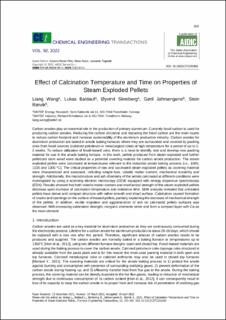| dc.contributor.author | Wang, Liang | |
| dc.contributor.author | Baldauf, Lukas | |
| dc.contributor.author | Skreiberg, Øyvind | |
| dc.contributor.author | Jahrsengene, Gøril | |
| dc.contributor.author | Rørvik, Stein | |
| dc.date.accessioned | 2022-09-27T06:37:56Z | |
| dc.date.available | 2022-09-27T06:37:56Z | |
| dc.date.created | 2022-07-04T17:30:20Z | |
| dc.date.issued | 2022 | |
| dc.identifier.citation | Chemical Engineering Transactions. 2022, 92 355-360. | en_US |
| dc.identifier.issn | 1974-9791 | |
| dc.identifier.uri | https://hdl.handle.net/11250/3021580 | |
| dc.description.abstract | Carbon anodes play an essential role in the production of primary aluminium. Currently fossil carbon is used for producing carbon anodes. Reducing the carbon utilization and replacing the fossil carbon are the main routes to reduce carbon footprint and increase sustainability of the aluminium production industry. Carbon anodes for aluminium production are baked in anode baking furnaces where they are surrounded and covered by packing coke from fossil sources (calcined petroleum or metallurgical coke) at high temperature for a period of up to 1-2 weeks. To reduce utilization of fossil-based coke, there is a need to identify, test and develop new packing material for use in the anode baking furnace. In this work, pellets produced from steam exploded and further pelletized stem wood were studied as a potential covering material for carbon anode production. The steam exploded pellets were calcinated at temperatures relevant to the industrial anode baking process (i.e., 1000, 1100 and 1300 ºC). The critical properties of raw and calcinated steam exploded pellets as covering material were characterized and assessed, including weight loss, volatile matter content, mechanical durability and strength. Additionally, the microstructure and ash chemistry of the pellets calcinated at different conditions were investigated by using a scanning electron microscopy (SEM) equipped with energy dispersive spectroscopy (EDX). Results showed that both volatile matter content and mechanical strength of the steam exploded pellets decrease upon increase of calcination temperature and residence time. SEM analysis revealed that untreated pellets have dense and compact structure with rather smooth and intact surface. Calcination caused formation of cracks and openings on the surface of treated pellets, partially explaining the decrease of mechanical strength of the pellets. In addition, visible migration and agglomeration of ash on calcinated pellets surfaces was observed. With increasing calcination strength, inorganic elements sinter and form a compact layer with Ca as the main element. | en_US |
| dc.language.iso | eng | en_US |
| dc.publisher | The Italian Association of Chemical Engineering | en_US |
| dc.title | Effect of calcination temperature and time on properties of steam exploded pellets | en_US |
| dc.title.alternative | Effect of calcination temperature and time on properties of steam exploded pellets | en_US |
| dc.type | Peer reviewed | en_US |
| dc.type | Journal article | en_US |
| dc.description.version | publishedVersion | en_US |
| dc.rights.holder | Copyright © 2022, AIDIC Servizi S.r.l. | en_US |
| dc.source.pagenumber | 355-360 | en_US |
| dc.source.volume | 92 | en_US |
| dc.source.journal | Chemical Engineering Transactions | en_US |
| dc.identifier.doi | 10.3303/CET2292060 | |
| dc.identifier.cristin | 2037098 | |
| dc.relation.project | Norges forskningsråd: 294679 | en_US |
| cristin.ispublished | true | |
| cristin.fulltext | original | |
| cristin.qualitycode | 1 | |
